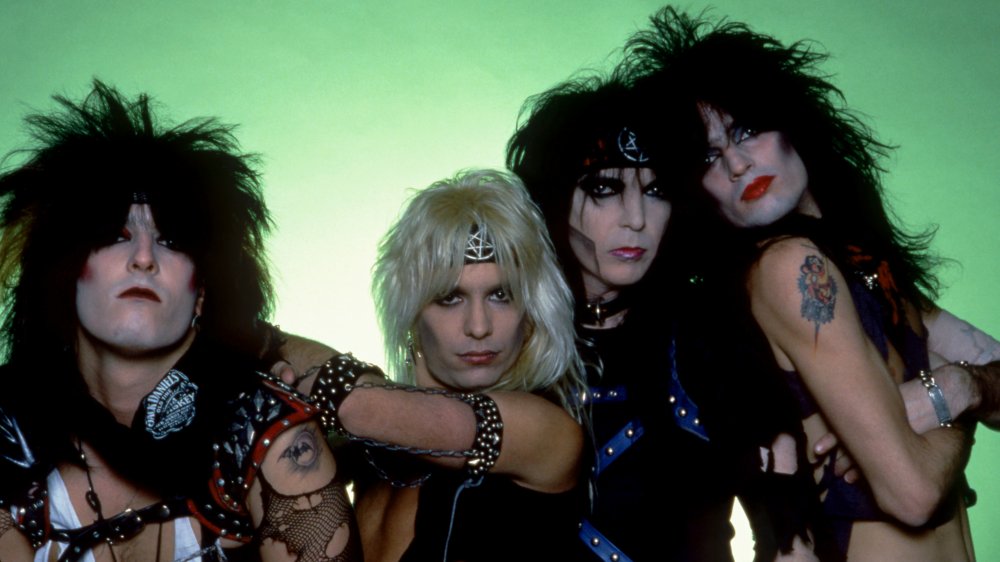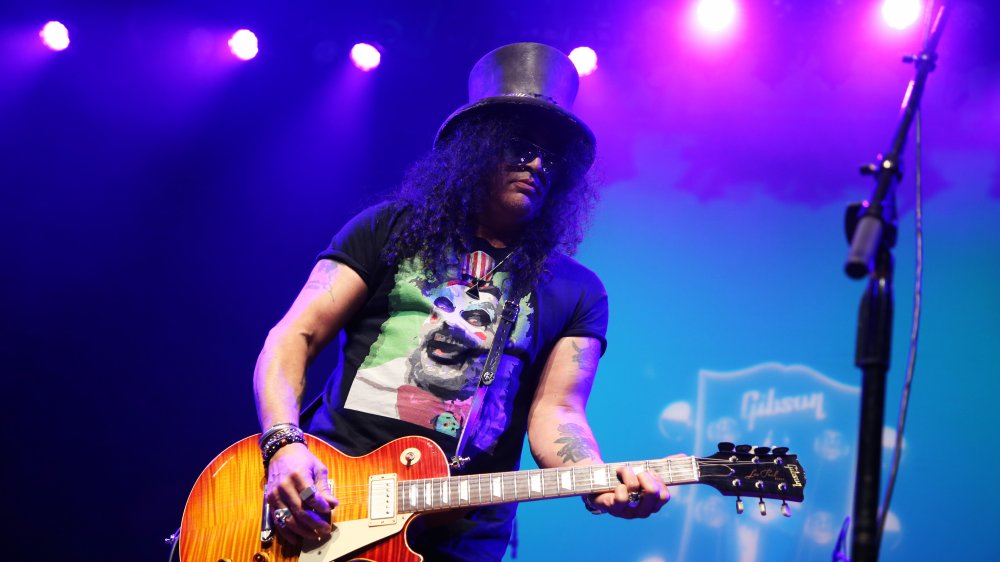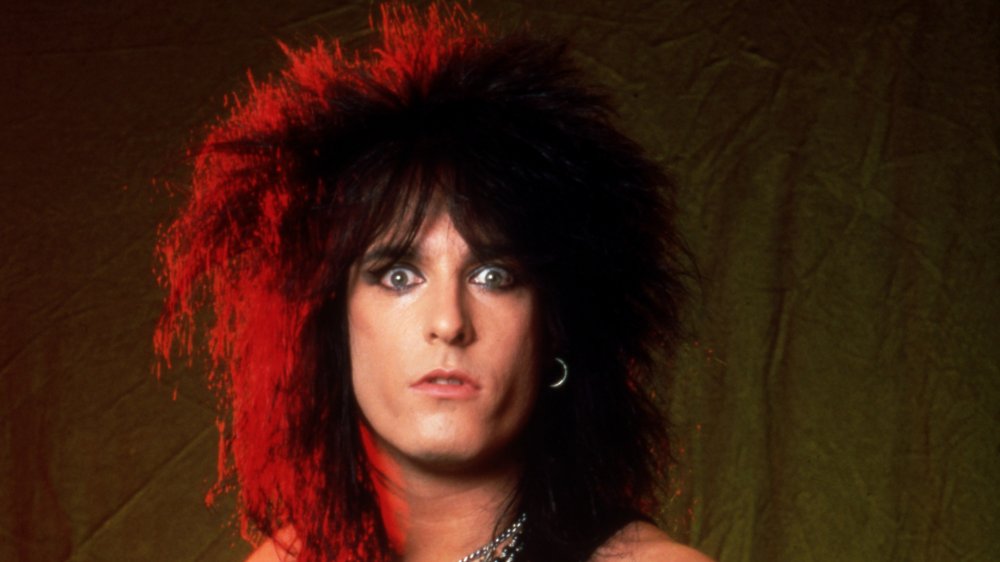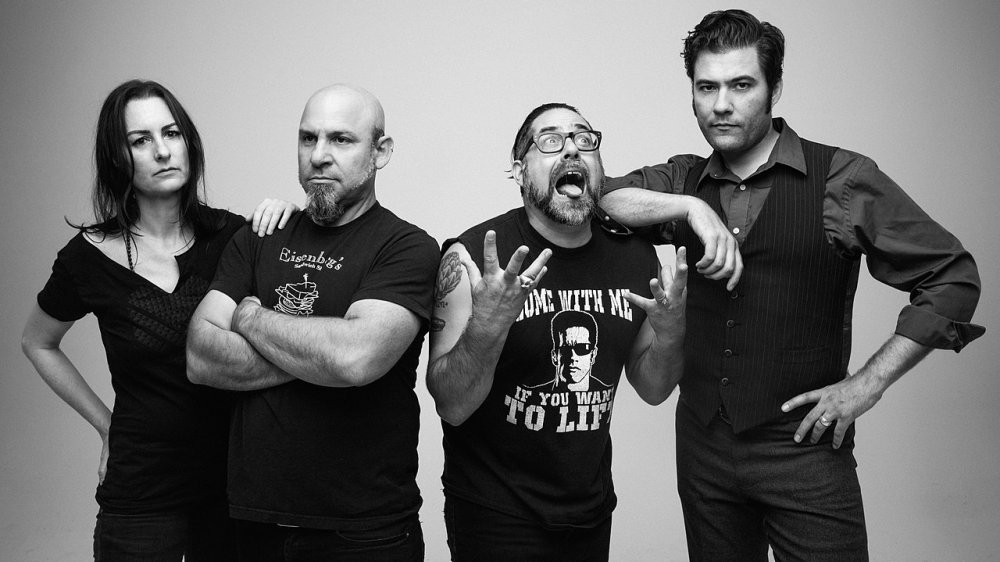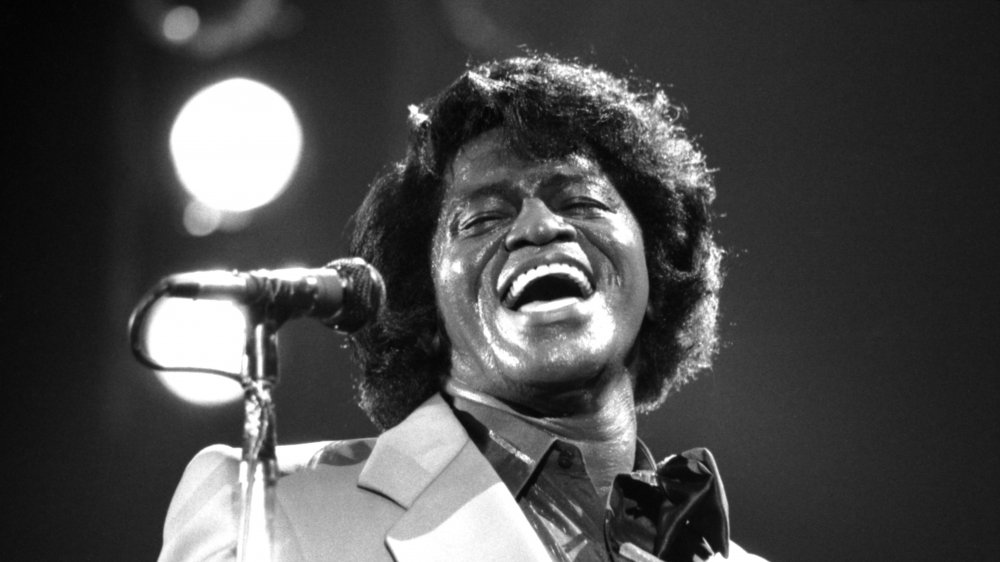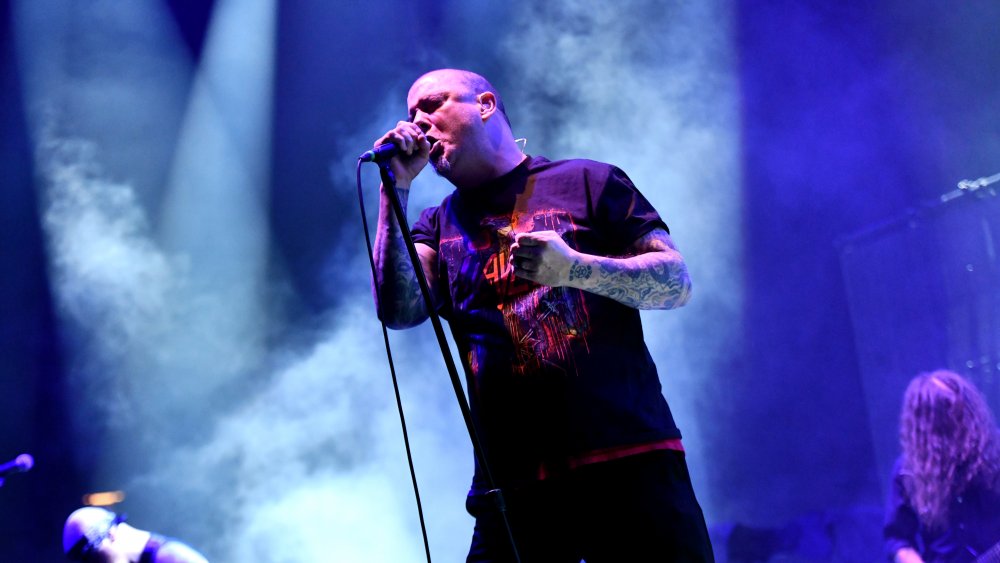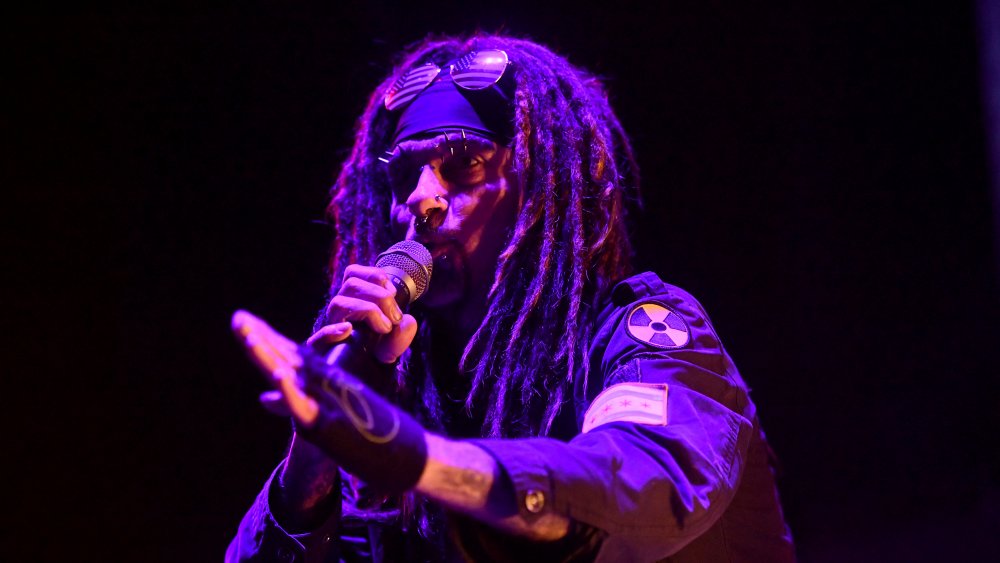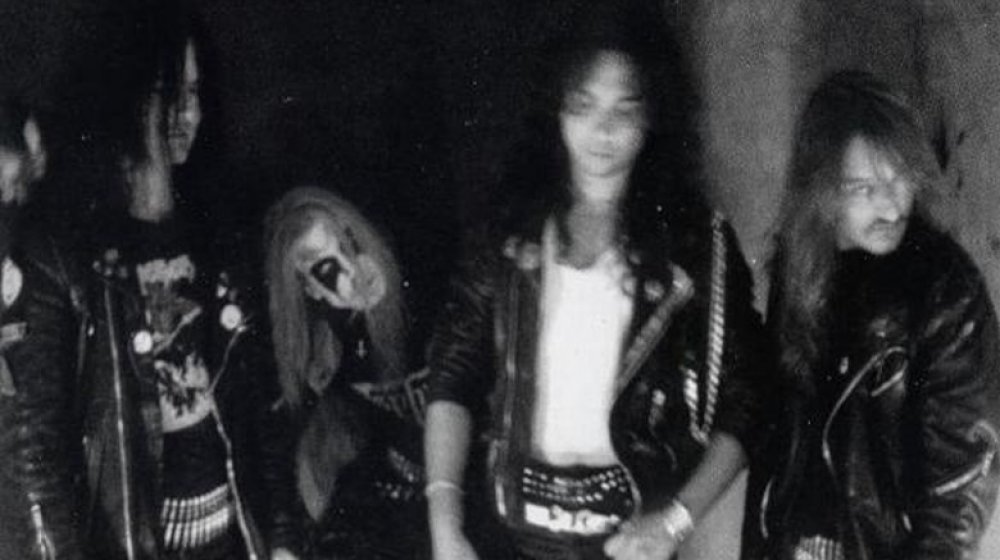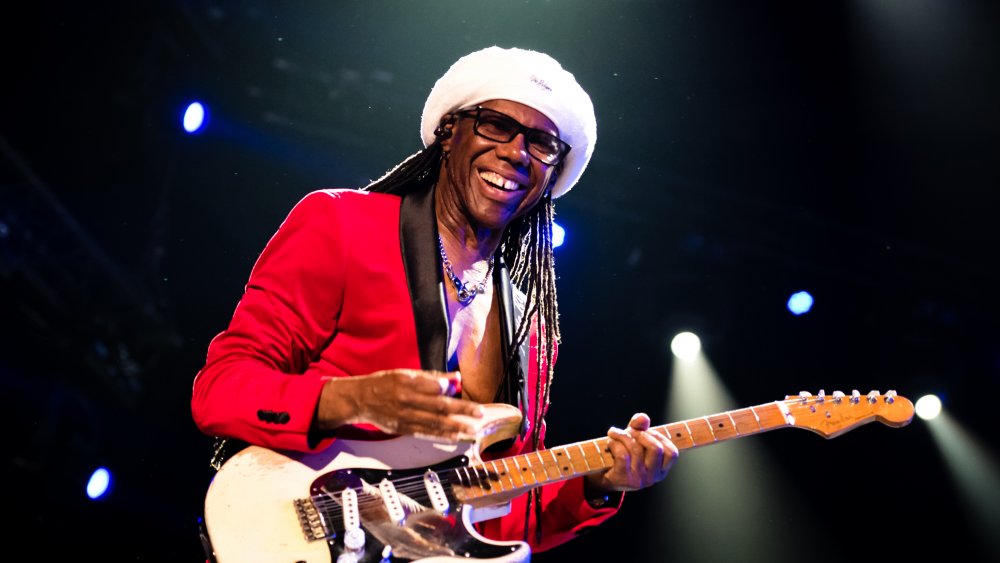Musicians Who Died And Were Brought Back To Life
Fair or not, when we think of famous musicians, we think of the "rock star" lifestyle. Even if the musician in question isn't a rocker, the phrase "professional musician" conjures up images of backstage orgies and questionable life decisions. It's easy to see why: The music business has so many famous members who died young — the actuarial tables must be a sight to see. While you might imagine that being a professional musician is just sitting around strumming an instrument, the music business is physically punishing in many ways. From marathon concert performances to the unending pressure to produce and record material, it's little wonder that so many musicians pay a physical toll.
Even more remarkable than the musicians who have died young are those who've died ... and come back. Okay, it's remarkable when anyone dies — like, really dies — and then comes back to life. But musicians bring so much joy and beauty into the world that it's particularly harsh when we lose them too early. That makes the musicians on this list who died and were brought back to life worth celebrating. Their miraculous resurrections translated directly into more great music we all get to enjoy.
Josh Homme died during routine surgery
Queens of the Stone Age are one of the most successful post-grunge rock bands, selling millions of albums and earning several Grammy nominations. Josh Homme founded the band in 1996 and has been the only consistent member ever since. Their breakthrough came with their 2002 album Songs for the Deaf and the global hit single "No One Knows," which remains their only chart-topping single (though they've had several number-one albums).
With that sort of classic rock star story, you might assume Homme's on this list for typically decadent reasons, but as Rolling Stone reports, it's much more mundane. Homme suffered a surprisingly common affliction for lead singers of rock bands: Knee problems. In 2010, the singer went into the hospital to have what should have been routine surgery on his knee. During the operation, Homme experienced complications with the anesthesia and choked on the oxygen tubes that had been placed down his throat. He flatlined on the table and was officially dead for a few minutes before his doctors revived him.
Homme then had to deal with a MRSA infection, which is difficult to treat because MRSA is resistant to antibiotics. According to the BBC, the experience understandably made Homme reflect on his life. "It gave me great perspective," he said, "and it's amazing to be alive."
Ozzy Osbourne died after flipping his ATV
Okay, if you were asked to guess the musicians on a list of "rock stars who died and came back," you'd probably guess Ozzy Osbourne. Few musicians have embodied the rock star lifestyle like Ozzy, from the superhuman consumption of various substances to the insane antics onstage. But Ozzy's brush with death didn't actually have anything to do with the rock star life, unless you consider enjoying some quad biking on your own property to be wild and crazy.
As CNN reports, in 2003, Ozzy was riding his all-terrain quad bike around his estate in Buckinghamshire, England, when he hit a pothole and lost control. He was thrown from the bike — and the bike landed on top of him. He fractured eight ribs and a vertebra in his neck, and as NME notes, he stopped breathing and had no pulse for a minute and a half, meaning he was technically dead.
His wife, Sharon, told reporters that a quick-acting security guard leaped into action and resuscitated Osbourne, bringing him back to life so he could be taken to the hospital for emergency surgery. As The Sun reported in 2019, Osbourne lived with metal rods in his back as a result of the accident for more than a decade — until a fall in his home dislodged some of them, requiring another round of surgery.
Slash was dead for eight minutes
Slash (real name: Saul Hudson) embodies the classic rock 'n' roll image. With his trademark top hat, dark glasses, and low-slung Gibson Les Paul guitar, he's instantly recognizable as the lead guitarist for Guns N' Roses, a band with quite the reputation for uniquely rock 'n' roll lifestyle choices. So it's probably not too surprising that Slash is one of the musicians who has died and come back to life — or that his near-death experience involves a drug overdose.
As The Guardian reports, the guitarist is pretty nonchalant and upbeat about the fact that he literally killed himself. In San Francisco, while on tour with Guns N' Roses, Slash says he called up some drug dealers, who came to his hotel room. "They had everything and I took all of it," he says. He then started walking to the elevators and collapsed in front of a very freaked-out cleaning woman.
According to Alternative Nation, Slash's heart stopped for eight long minutes as he lay on the floor of the hotel hallway. Paramedics arrived and injected adrenaline into his chest, and he revived. It took a few more years, but Slash finally got the message after he was diagnosed with heart disease at the age of 35 in 2001. He's been sober since 2005.
Kick-starting Nikki Sixx's heart
The poster boy for rock excess, the fact that Nikki Sixx is still among the living is a miracle. Now sober for nearly two decades, the Mötley Crüe bassist once said, "alcohol, acid, cocaine ... they were just affairs. When I met heroin, it was true love."
It also almost ended him. In 1987, Mötley Crüe was riding high. They'd just released their second multiplatinum album in a row, Girls, Girls, Girls, solidifying their status as one of the biggest rock bands in the world. As Rolling Stone reports, Sixx celebrated this success by overdosing on heroin so badly that his heart stopped for two whole minutes. An ambulance came, and not one but two adrenaline shots were required to literally kick-start his heart and bring him back to life.
The incident inspired his song "Kickstart My Heart" on the band's 1989 album Dr. Feelgood. Interestingly, according to Loudwire, Steven Adler, the drummer for Guns N' Roses, was with Sixx that day and disputes the story. Adler claims that he revived Sixx after his overdose by dragging him into a cold shower and that no adrenaline was necessary. Whichever version of the story is true, one thing is certain: Sixx is lucky to be alive.
Aaron Lazar's heart just stopped
The Giraffes aren't the most famous rock band around. The word "cult" is usually thrown around, because the Brooklyn-based band has been active since 1996 and has a reputation for putting on electric, unpredictable live shows.
Lead singer Aaron Lazar joined the band in 2001, solidifying their lineup. Four years later, when he was 27 years old, Lazar was driving with his girlfriend one night when he suddenly slumped over the wheel, losing consciousness. According to New York Magazine, when he regained consciousness, doctors told him that he'd died twice, his heart stopping each time.
They eventually figured out that Lazar suffered from an event known as Sudden Cardiac Death (SCD), which is responsible for half the heart disease deaths in the world. It's not a heart attack — the heart simply stops beating, and only five percent of people survive. Once they knew what they were dealing with, they implanted a defibrillator into Lazar. If his heart stops beating, the device will automatically send an electrical charge into the muscle to get it started again.
Lazar has maintained a good sense of humor about his health, once telling Hear Nebraska he wasn't worried about dying onstage. "If I'm gonna have a heart attack, I'm gonna have a heart attack. I've had heart attacks watching television."
James Brown was born dead
When talking about people who've come back from the dead, we're usually discussing adults. When talking about musicians who've come back from the dead, we're usually talking about adults who've engaged in some kind of dangerous behavior. But when James Brown came back from the dead, he hadn't actually even been alive yet.
As The New York Times notes, Brown was born into an extremely poor family. When the time came for the delivery, there was no hospital — or doctor. Brown was born in a small shack in Barnwell, South Carolina, attended to by two aunts acting as midwives. At first, everyone thought Brown had emerged stillborn — his heart wasn't beating, and he wasn't breathing. According to author R.J. Smith, Brown's mother Susie began to weep, convinced that her son had been born dead.
But his quick-acting Aunt Minnie revived the baby with some CPR, and he took his first breath. Considering how hard he had to work just to exist, it's little surprise that Brown became known as the hardest-working man in show businesses. Brown loved to tell the story, believing that his miraculous comeback from death marked him as special — and who could argue with the Godfather of Soul?
Phil Anselmo has "croaked a few times"
Pantera is a legendary heavy metal band who dominated the music charts in the late 1980s and early 1990s — their 1994 album, Far Beyond Driven, hit Number One on the Billboard charts. Songs like the all-time classic "Walk" made guitarist Dimebag Darrell and lead singer Phil Anselmo legends in their own right.
As The Times-Picayune reports, what fans didn't know as they were rocking out to the band's music is that Anselmo was suffering serious pain due to ruptured discs. In fact, Loudwire notes that the first single from that classic album, "I'm Broken," was about Anselmo's excruciating pain and his struggles with the feelings of vulnerability and weakness it inspired.
In order to continue to perform, he self-medicated with alcohol, painkillers, and eventually heroin. As he revealed in an interview with Andivero Magazine, his heroin use led to an overdose while the band was on tour in 1996 — his heart stopped, and he was clinically dead for about five minutes. Amazingly, as Rolling Stone notes, this wasn't the only time Anselmo has briefly died and come back — he joked, "As a guy who's croaked a few times, I'll let you know straight up, there wasn't much there. And if there was, it ain't memorable. It was pretty peaceful from what I remember."
Dave Gahan came back from the dead in handcuffs
As the lead singer for Depeche Mode, Dave Gahan has achieved worldwide fame and success. Known for his deep baritone, he's one of the most recognizable voices in modern music. You don't have to be a huge Depeche Mode fan to know instantly that Gahan is singing.
Like many artists, Gahan struggled with fame and being comfortable in his own skin. He became addicted to heroin and suffered so many overdoses that reportedly, paramedics began referring to him as "The Cat" due to his apparent nine lives. He attempted suicide in 1995, slashing his wrists. But his true rock bottom came a year later, when he overdosed again and briefly died. As The Chicago Tribune reports, when he regained consciousness, he asked the paramedics if he'd overdosed again — and their response was "No, David, you died. You flatlined for a couple of minutes. You were actually dead."
What probably saved his life was his arrest after the incident — Gahan woke up handcuffed to his bed, with police already there to read him his rights as they arrested him for drug possession. He was sent to a rehabilitation center, and as NME reports, he was afraid of being sent to jail if he failed a drug test. As a result, he adhered to the year-long program faithfully.
Al Jourgensen died from a ruptured ulcer
The lead singer of industrial band Ministry has never been known for his restraint in anything. From his aggressive approach to music and live performances to his epic drug use — he was a heroin addict for 20 years, and his version of sobriety is to limit himself to beer and marijuana – Al Jourgensen has been one of the most unpredictable figures in rock music for decades.
All of this makes it surprising that when Jourgensen flatlined in an emergency room in 2010, it had nothing to do with drugs. As Loudwire reports, Jourgensen had been vomiting blood for some time but assumed it was nothing to worry about and ignored the problem. The Guardian notes that in 2010, many fans thought his onstage behavior was due to his alcoholism and drug use, but in fact, it may have been caused by his gastrointestinal problems.
When Jourgensen collapsed and had a seizure, he was taken to the ICU, where he flatlined several times had to be shocked back to life. Eventually, doctors found his stomach and intestines filled with ulcers — 13 in all. One of the ulcers in his stomach was located over an artery and had ruptured, briefly killing him. Understandably, the experience inspired Jourgensen to sober up and live a healthier lifestyle. He managed to kick his drug habit on his own, but in 2014, he entered an alcohol treatment program, admitting he needed a little help to dry out.
Paul Robertson saw the other side
If you're not a classical music fan, you might not know Paul Robertson's name. He was a celebrated and influential violinist who earned a scholarship to the Royal Academy of Music at the age of 15 and founded the Medici String Quartet a few years later. Robertson played first violin for the quartet for the next four decades, famously playing a violin crafted by Venetian luthier Domenico Montagnana in the 1720s.
Robertson suffered from terminal heart disease in the final years of his life. As The Sun reports, he suffered a ruptured aorta in 2008 and died for a few minutes on the operating table. When he came back to life, he reported a series of near-death visions. He claimed to have ascended to heaven, to have been cast back down into hell — and to have inhabited the body of a dog running through the Arctic.
He dedicated the final years of his life to exploring the role of music in our physical and spiritual health. He founded the Music Mind Spirit Trust with his wife, Dr. Chika Robertson, and published a memoir, Soundscapes, describing his new perspective on creativity and learning. When he died for a second time, eight years after his first experience, Robertson left behind an incredible legacy of beautiful music and an earnest attempt to understand music's role in our lives.
Per Yngve Ohlin was beaten to death as a child
Unless you're into Norwegian Black Metal (hey, no judgments), you might not be familiar with Per Yngve Ohlin (aka Dead), the lead singer of the seminal band Mayhem. He chose his stage name very purposefully, because death kind of defined his entire life. As Fanpop recounts, Per Ohlin didn't have a very happy childhood in Sweden. He was severely bullied and was once beaten up so badly by classmates that he suffered a ruptured spleen and had to be rushed to the hospital. There, he died for a few minutes but was revived by doctors.
Ohlin came out of the experience changed. He probably suffered from what's known as Cotard's delusion, the belief that he was literally dead — that he'd never come back to life. He was obsessed with death for the rest of his life. His performances with Mayhem were legendary — he often hurt himself onstage and performed other shocking acts. He was encouraged in these self-destructive behaviors by his bandmate Øystein Aarseth (stage name Euronymous), who was later accused of using Ohlin's tragic death as promotional material for the band.
As Kerrang notes, it was very likely that the influential singer suffered from clinical depression at a minimum. He committed suicide in 1991.
If you or anyone you know is having suicidal thoughts, please call the National Suicide Prevention Lifeline at 1-800-273-TALK (8255).
Nile Rodgers died eight times in one night
Nile Rodgers, the legendary guitarist, songwriter, producer, and founder of Chic, has been a force in music since the early 1970s. Aside from his own success on the charts, he's worked with just about every major musician of the last four decades.
He also had a serious substance abuse problem. As the Knoxville News Sentinel reports, the last time he drank alcohol or took drugs was in the mid-1990s. He attended a birthday party for Madonna and hung out with actor Robert Downey, Jr. (someone else known at the time for his partying lifestyle), indulged in cocaine and alcohol, and literally died eight separate times. In fact, as The Independent notes, doctors were filling out the paperwork to declare him dead when he started breathing again.
The incident scared Rodgers straight. That night was the last time he took a drink or abused any sort of drug. But it wasn't fear of death that did the trick — it was listening to himself playing guitar while under the influence. Rodgers had thought his performance was incredible (he says "The crowd was going bananas. I thought that because the crowd loved it, I was killing it"), but hearing it back while sober made him incredibly embarrassed. He checked into rehab the next day, stayed there for eight months, and never looked back.
